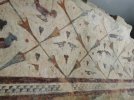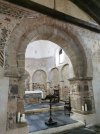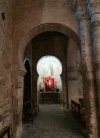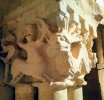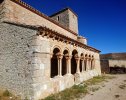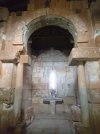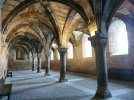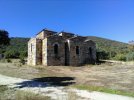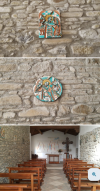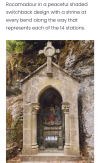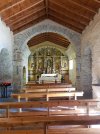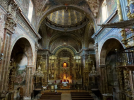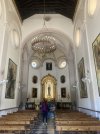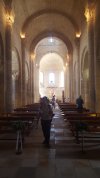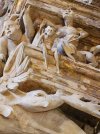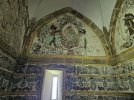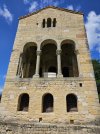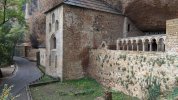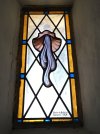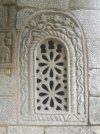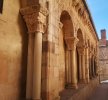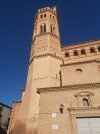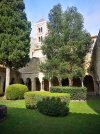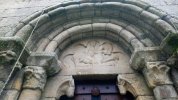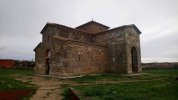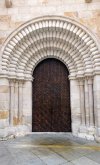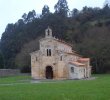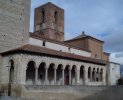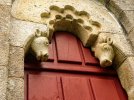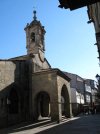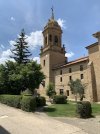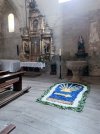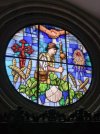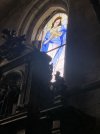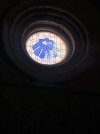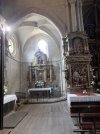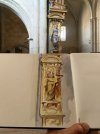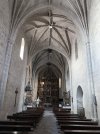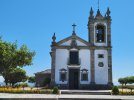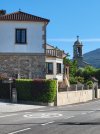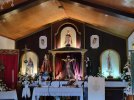Kevin Considine
Active Member
- Time of past OR future Camino
- 2021
The affect of a church on each of us is highly subjective and possibly based on many considerations, including; location, architecture, a particular statue, perhaps a memory inspired by an art piece. Mostly I suspect our current state of mind and spirit. For me the small churches along The Camino have had a greater impact than the great Cathedrals of Spain with the single exception of The Cathedral of Santiago. I have found those moments where you feel connected to God are more likely to occur in the smaller churches. This is of course a very personal list, so I am interested to hear from others on their own choices and would love to visit other inspiring houses of God along The Way.
I also found it amusing that this piece started out as "The Top 5 Small Churches" but as I wrote beautiful memories of many Caminos arose and my list grew. I could have easily added another 5.
1. Church of The Assumption in Rabanal del Camino on Camino Frances:
A 12th Century Romanesque Church possibly built by The Templars. Some people suggest this small chapel is in disrepair but I feel it is perfect as it is. There are exposed stones and some crumbling you see but then the arched ceiling still has magnificent colors and the simple crucifix in the stone wall is powerful depiction of Jesus. Of all the cathedrals, churches and chapels on the Camino it is here where I feel closest to him perhaps because of its simplicity. The daily evening Vespers session led by a half dozen Benedictine monks is a wonderful end to a pilgrim’s day. They also have pilgrims recite prayers in a few different languages adding to the experience. This special church also happens to be across the street from one of the better albergues on any Camino, Gaucelmo, which is run by English and Irish hospitaleros.
2. Chapel of Santa Maria de Corticela inside The Cathedral de Santiago:
Built in the 9th Century originally part of the Benedictine monk community from the Monastery of St. Martin Piñario next door. Though it is one of a few chapels inside the Cathedral, a thousand years ago it was unattached to a smaller Cathedral. I like to visit the Cathedral early around 7AM and always end up at this powerful small chapel having it to myself. The stained glass window behind the altar is one of the most touching depictions of the Crucifixion anywhere. This small chapel feels different than the Cathedral, probably because it is. Certainly older. Perhaps more spiritual as if you were now alone with God. Moving depiction of the Crucifixion
3. Sanctuary of the Virgin of Barca in Muxia:
Unlike most of the other churches on this list, it is not old having been rebuilt and restored 4 times with the last being in 2015 after serious fire damage. It is most special because of its magical location on the seafront just steps down a hill from the Camino 0 Mile Marker and the Prestige Oil Spill of 2003 Memorial. On the other side is the beautiful lighthouse. Walking out of the church one faces west where the Atlantic waves pound into the large boulders along the shore. There are 4 large stones which legend says are the remains of the Boat the Virgin Mary sailed to Galicia in here to support St. James, including; the Oscilating Stone, the Kidney Stone, the Lovers Stone and the Rudder Stone. Until recently the church has been closed other than for 7PM daily and Sunday Mass. The new young priest, Father Jose Antonio, has embraced the pilgrim community and opened the church on a daily basis from midmorning to around sunset. There is now choir music being piped outside which only enhances the spiritual experience. Walking inside I adore the several small model boats hanging from the ceiling and placed on the walls, connecting this small village to it's history as well as The Camino. How I wish that all of Spain will follow and open up the churches once again to the thousands of pilgrims who may be in need of a solitary moment of prayer.
4. Church of Saint Julian de Moraime at the Monastery de Moraime near Muxia:
This 12th Century Romanesque Church is a 3 kilometer walk from Muxia on The Camino returning to Santiago. Like all Romanesque churches it is simple, but what sets it apart are its beautiful colored frescoes in the process of being restored. I also particularly like the apse with its simple crucifix behind the altar. I attended a concert here a few weeks ago and the acoustics were outstanding.
5. Church of Santa Maria de Eunate about 2 kilometers southeast of Muruzábal, Navarra:
Another 12th Century Romanesque Church said to have been built by The Templars. It stands alone, which enhances the spiritual connection, just 2 kilometers east of Puente La Reina of the Camino Frances and right on Camino Aragones, clearly modeled after Holy Sepulchre in Jerusalem. The eight sided church is built of dressed stone with a little three-side apse. It is surrounded by an austere though beautifully constructed unroofed cloister.
6. The Colegiata de Santa Maria la Real de Sar in Santiago de Compostela:
One more Romanesque Church built in the early years of the 12th Century. It's rugged cloister is attributed to Maestro Mateo famed for his Portico de la Gloria in the Cathedral de Santiago. It is beautiful but what makes the church unique is its architecture. It's two lines of heavy interior columns are not perpendicular. They are cocked outward from the central nave and seemingly about to topple over. When the great earthquake of Lisbon in 1755 toppled churches throughout Galicia, the people of Santiago were surprised that the "falling church" held firm. However the walls were weakened so they added massive flying buttresses to the outside. Why this church leans is still a matter of speculation. One of a kind. There is a charge to enter but free entry is included with Santiago Cathedral Museum tickets.
7. Church of St. John The Baptist in Grañon on Camino Frances:
This is a special stop on The Camino where pilgrims sleep in a loft on mats in an attached building in the back of the church. This parish albergue is unique in that it offers not stamps but hugs to arriving pilgrims. Upstairs there is a single large attic loft with low ceilings where the pilgrims pack tightly together sleeping on mats. There are no beds. Pilgrims walk a "secret" passageway to a small landing above the church where there is a beautiful stained glass depiction of Santiago. There is a stairway then continuing down to the back of the church. The whole experience is magical. After Mass some of the pilgrims return to the landing to talk of the impact of the Camino on their spirits.
8. The Royal Collegiate Church of St. Mary in the Abbey in Roncesvalles:
Built by King Sancho VII but consecrated after his death in 1219. It has an interesting museum including Charlemagne's Chessboard. Adjoining the Church is a rebuilt cloisters and beyond that a door leading to a mausoleum housing Sancho and his wife Clemencia. I had walked 2,000 kilometers there and during the Mass I felt a strong connection to the statue of Mary above the altar, seeing her as I felt the pagans of old did, as Mother Nature. There was a day of course when pagans were forced to join the Church or be at the mercy of the KIng or local Lord. That night they had a Celtic concert with music that was over 500 years old. and singers inside and outside the Mausoleum. Powerful.
9. Church of Our Lady of Mt. Faro near Chantada on Camino Invierno:
What made this special is it required a 460 meter ascent to reach this mountaintop Church. The last few hundred meters there were wood crosses depicting the Stations of The Cross. The first time I reached it was closed. The second time there were workers so I was able to enter the empty candlelit church. A very special moment for a solo pilgrim.
10. Church of The Holy Sepulchre in Torres Del Rio on Camino Frances:
About 8 kilometers west of Los Arcos in Navarra, on Camino Frances lies another 12th Century Romanesque Church. Not only is it modeled after Holy Sepulchre but named after it as well. Its octagonal architectural design was used by many chivalric orders, such as the Knights Templar or the Order of the Holy Sepulchre. Even today people still argue about its origin and whether it really belongs to the Order of the Holy Sepulchre or, rather, to the nearby Monastery of Irache. If you are lucky enough to find it open on your Camino, the most remarkable element of its extraordinary architecture is the interior of its vault. It is a ribbed vault very close to the Hispano-Muslim domes, since on its surface eight arches intersect forming a star and giving rise to a central octagon with a circle of interlacings inscribed on it.
11. Church of Santa Maria Real in O Cebreiro on Camino Frances:
This may be a small church but it's location at O Cebreiro Pass and it being the site of a miracle make it a very special stop for pilgrims. A dismissive priest was upset at having to brave the cold to say Mass for one humble shepherd who attended Mass daily and risked life and limb the night of a horrible winter storm to attend Mass. As the priest spoke, a flash of light filled the sanctuary and on that altar the bread turned into the Body of Christ, and the wine became His Blood. The voice of Jesus said to the priest, "I too have come to hear Mass said this night, for I too am a shepherd. Also, this church is the final resting place of Father Elias Valiña Sampedro who was the parish priest in O Cebreiro and was instrumental in bringing The Camino back to life in the 1980's.
12. Church of Saint Martin in Monreal on Camino Aragones:
A simple church with one of the more beautiful depictions of St. Martin on horseback cutting his cloak in half to give to a beggar. It's old wood floors with numbers for buried dead adds to the power. I stumbled on it the evening before walking to Santa Maria de Eunate.
13. Chapel of The Holy Christ in Peñaflor de Hornija on Camino de Madrid:
I happened to walk to this hilltop Chapel during a beautiful sunset while a Novena was being held and there was a kissing of the Cross ceremony. It is a stone chapel of simple design. However the overall effect and experience was quite moving.
14. Monastery of Zenarruza on a mountaintop in Ziortza on Camino del Norte:
I am a sucker for mountaintops and after a challenging walk, perched on a wall in the courtyard next to a huge bell waiting for Mass was a highly emotional moment having come a very long way by foot. After a lovely Mass with quite a few of the Cistercian Monks in attendance I ventured over to their shop run by a most friendly monk, Father Ramon, who came out from behind his counter and placed a shell necklace around my neck. I wore that necklace for several thousand kilometers of pilgrimages over the next few years. Walking back to their cozy albergue, I found one of the monks busy cooking up a delicious spaghetti dinner for all their pilgrim guests.
15. The Pilgrim's Office Chapel in Santiago de Compostela:
At the end of our Caminos almost all pilgrims attend Mass at the Cathedral hoping to see the Botafumeiro swing from the rafters. However, as you enter the Pilgrims Office seeking your Compostela or certificate, to the left just past the entry door there is a small chapel. Daily at 10:30 in the morning, there is a Pilgrim's Mass in English. It is a much more intimate experience than Mass at the Cathedral. Father Manny is a friendly and kind Filipino Priest who embraces pilgrims with touching sermons and encouraging pilgrims to say a few words about their pilgrimage. It can be quite inspiring. I walked in December 2022, and attended Father Manny's Service. There were just a few of us but he has a way of making you feel special and blessed.
In conclusion, Writing this brought back a flood of great Camino memories. I hope you take the time to respond with your own experiences and recommendations to your fellow pilgrims.
Buen Camino and Ultreia.
Full post with pictures and links at globalpilgrim
I also found it amusing that this piece started out as "The Top 5 Small Churches" but as I wrote beautiful memories of many Caminos arose and my list grew. I could have easily added another 5.
1. Church of The Assumption in Rabanal del Camino on Camino Frances:
A 12th Century Romanesque Church possibly built by The Templars. Some people suggest this small chapel is in disrepair but I feel it is perfect as it is. There are exposed stones and some crumbling you see but then the arched ceiling still has magnificent colors and the simple crucifix in the stone wall is powerful depiction of Jesus. Of all the cathedrals, churches and chapels on the Camino it is here where I feel closest to him perhaps because of its simplicity. The daily evening Vespers session led by a half dozen Benedictine monks is a wonderful end to a pilgrim’s day. They also have pilgrims recite prayers in a few different languages adding to the experience. This special church also happens to be across the street from one of the better albergues on any Camino, Gaucelmo, which is run by English and Irish hospitaleros.
2. Chapel of Santa Maria de Corticela inside The Cathedral de Santiago:
Built in the 9th Century originally part of the Benedictine monk community from the Monastery of St. Martin Piñario next door. Though it is one of a few chapels inside the Cathedral, a thousand years ago it was unattached to a smaller Cathedral. I like to visit the Cathedral early around 7AM and always end up at this powerful small chapel having it to myself. The stained glass window behind the altar is one of the most touching depictions of the Crucifixion anywhere. This small chapel feels different than the Cathedral, probably because it is. Certainly older. Perhaps more spiritual as if you were now alone with God. Moving depiction of the Crucifixion
3. Sanctuary of the Virgin of Barca in Muxia:
Unlike most of the other churches on this list, it is not old having been rebuilt and restored 4 times with the last being in 2015 after serious fire damage. It is most special because of its magical location on the seafront just steps down a hill from the Camino 0 Mile Marker and the Prestige Oil Spill of 2003 Memorial. On the other side is the beautiful lighthouse. Walking out of the church one faces west where the Atlantic waves pound into the large boulders along the shore. There are 4 large stones which legend says are the remains of the Boat the Virgin Mary sailed to Galicia in here to support St. James, including; the Oscilating Stone, the Kidney Stone, the Lovers Stone and the Rudder Stone. Until recently the church has been closed other than for 7PM daily and Sunday Mass. The new young priest, Father Jose Antonio, has embraced the pilgrim community and opened the church on a daily basis from midmorning to around sunset. There is now choir music being piped outside which only enhances the spiritual experience. Walking inside I adore the several small model boats hanging from the ceiling and placed on the walls, connecting this small village to it's history as well as The Camino. How I wish that all of Spain will follow and open up the churches once again to the thousands of pilgrims who may be in need of a solitary moment of prayer.
4. Church of Saint Julian de Moraime at the Monastery de Moraime near Muxia:
This 12th Century Romanesque Church is a 3 kilometer walk from Muxia on The Camino returning to Santiago. Like all Romanesque churches it is simple, but what sets it apart are its beautiful colored frescoes in the process of being restored. I also particularly like the apse with its simple crucifix behind the altar. I attended a concert here a few weeks ago and the acoustics were outstanding.
5. Church of Santa Maria de Eunate about 2 kilometers southeast of Muruzábal, Navarra:
Another 12th Century Romanesque Church said to have been built by The Templars. It stands alone, which enhances the spiritual connection, just 2 kilometers east of Puente La Reina of the Camino Frances and right on Camino Aragones, clearly modeled after Holy Sepulchre in Jerusalem. The eight sided church is built of dressed stone with a little three-side apse. It is surrounded by an austere though beautifully constructed unroofed cloister.
6. The Colegiata de Santa Maria la Real de Sar in Santiago de Compostela:
One more Romanesque Church built in the early years of the 12th Century. It's rugged cloister is attributed to Maestro Mateo famed for his Portico de la Gloria in the Cathedral de Santiago. It is beautiful but what makes the church unique is its architecture. It's two lines of heavy interior columns are not perpendicular. They are cocked outward from the central nave and seemingly about to topple over. When the great earthquake of Lisbon in 1755 toppled churches throughout Galicia, the people of Santiago were surprised that the "falling church" held firm. However the walls were weakened so they added massive flying buttresses to the outside. Why this church leans is still a matter of speculation. One of a kind. There is a charge to enter but free entry is included with Santiago Cathedral Museum tickets.
7. Church of St. John The Baptist in Grañon on Camino Frances:
This is a special stop on The Camino where pilgrims sleep in a loft on mats in an attached building in the back of the church. This parish albergue is unique in that it offers not stamps but hugs to arriving pilgrims. Upstairs there is a single large attic loft with low ceilings where the pilgrims pack tightly together sleeping on mats. There are no beds. Pilgrims walk a "secret" passageway to a small landing above the church where there is a beautiful stained glass depiction of Santiago. There is a stairway then continuing down to the back of the church. The whole experience is magical. After Mass some of the pilgrims return to the landing to talk of the impact of the Camino on their spirits.
8. The Royal Collegiate Church of St. Mary in the Abbey in Roncesvalles:
Built by King Sancho VII but consecrated after his death in 1219. It has an interesting museum including Charlemagne's Chessboard. Adjoining the Church is a rebuilt cloisters and beyond that a door leading to a mausoleum housing Sancho and his wife Clemencia. I had walked 2,000 kilometers there and during the Mass I felt a strong connection to the statue of Mary above the altar, seeing her as I felt the pagans of old did, as Mother Nature. There was a day of course when pagans were forced to join the Church or be at the mercy of the KIng or local Lord. That night they had a Celtic concert with music that was over 500 years old. and singers inside and outside the Mausoleum. Powerful.
9. Church of Our Lady of Mt. Faro near Chantada on Camino Invierno:
What made this special is it required a 460 meter ascent to reach this mountaintop Church. The last few hundred meters there were wood crosses depicting the Stations of The Cross. The first time I reached it was closed. The second time there were workers so I was able to enter the empty candlelit church. A very special moment for a solo pilgrim.
10. Church of The Holy Sepulchre in Torres Del Rio on Camino Frances:
About 8 kilometers west of Los Arcos in Navarra, on Camino Frances lies another 12th Century Romanesque Church. Not only is it modeled after Holy Sepulchre but named after it as well. Its octagonal architectural design was used by many chivalric orders, such as the Knights Templar or the Order of the Holy Sepulchre. Even today people still argue about its origin and whether it really belongs to the Order of the Holy Sepulchre or, rather, to the nearby Monastery of Irache. If you are lucky enough to find it open on your Camino, the most remarkable element of its extraordinary architecture is the interior of its vault. It is a ribbed vault very close to the Hispano-Muslim domes, since on its surface eight arches intersect forming a star and giving rise to a central octagon with a circle of interlacings inscribed on it.
11. Church of Santa Maria Real in O Cebreiro on Camino Frances:
This may be a small church but it's location at O Cebreiro Pass and it being the site of a miracle make it a very special stop for pilgrims. A dismissive priest was upset at having to brave the cold to say Mass for one humble shepherd who attended Mass daily and risked life and limb the night of a horrible winter storm to attend Mass. As the priest spoke, a flash of light filled the sanctuary and on that altar the bread turned into the Body of Christ, and the wine became His Blood. The voice of Jesus said to the priest, "I too have come to hear Mass said this night, for I too am a shepherd. Also, this church is the final resting place of Father Elias Valiña Sampedro who was the parish priest in O Cebreiro and was instrumental in bringing The Camino back to life in the 1980's.
12. Church of Saint Martin in Monreal on Camino Aragones:
A simple church with one of the more beautiful depictions of St. Martin on horseback cutting his cloak in half to give to a beggar. It's old wood floors with numbers for buried dead adds to the power. I stumbled on it the evening before walking to Santa Maria de Eunate.
13. Chapel of The Holy Christ in Peñaflor de Hornija on Camino de Madrid:
I happened to walk to this hilltop Chapel during a beautiful sunset while a Novena was being held and there was a kissing of the Cross ceremony. It is a stone chapel of simple design. However the overall effect and experience was quite moving.
14. Monastery of Zenarruza on a mountaintop in Ziortza on Camino del Norte:
I am a sucker for mountaintops and after a challenging walk, perched on a wall in the courtyard next to a huge bell waiting for Mass was a highly emotional moment having come a very long way by foot. After a lovely Mass with quite a few of the Cistercian Monks in attendance I ventured over to their shop run by a most friendly monk, Father Ramon, who came out from behind his counter and placed a shell necklace around my neck. I wore that necklace for several thousand kilometers of pilgrimages over the next few years. Walking back to their cozy albergue, I found one of the monks busy cooking up a delicious spaghetti dinner for all their pilgrim guests.
15. The Pilgrim's Office Chapel in Santiago de Compostela:
At the end of our Caminos almost all pilgrims attend Mass at the Cathedral hoping to see the Botafumeiro swing from the rafters. However, as you enter the Pilgrims Office seeking your Compostela or certificate, to the left just past the entry door there is a small chapel. Daily at 10:30 in the morning, there is a Pilgrim's Mass in English. It is a much more intimate experience than Mass at the Cathedral. Father Manny is a friendly and kind Filipino Priest who embraces pilgrims with touching sermons and encouraging pilgrims to say a few words about their pilgrimage. It can be quite inspiring. I walked in December 2022, and attended Father Manny's Service. There were just a few of us but he has a way of making you feel special and blessed.
In conclusion, Writing this brought back a flood of great Camino memories. I hope you take the time to respond with your own experiences and recommendations to your fellow pilgrims.
Buen Camino and Ultreia.
Full post with pictures and links at globalpilgrim




